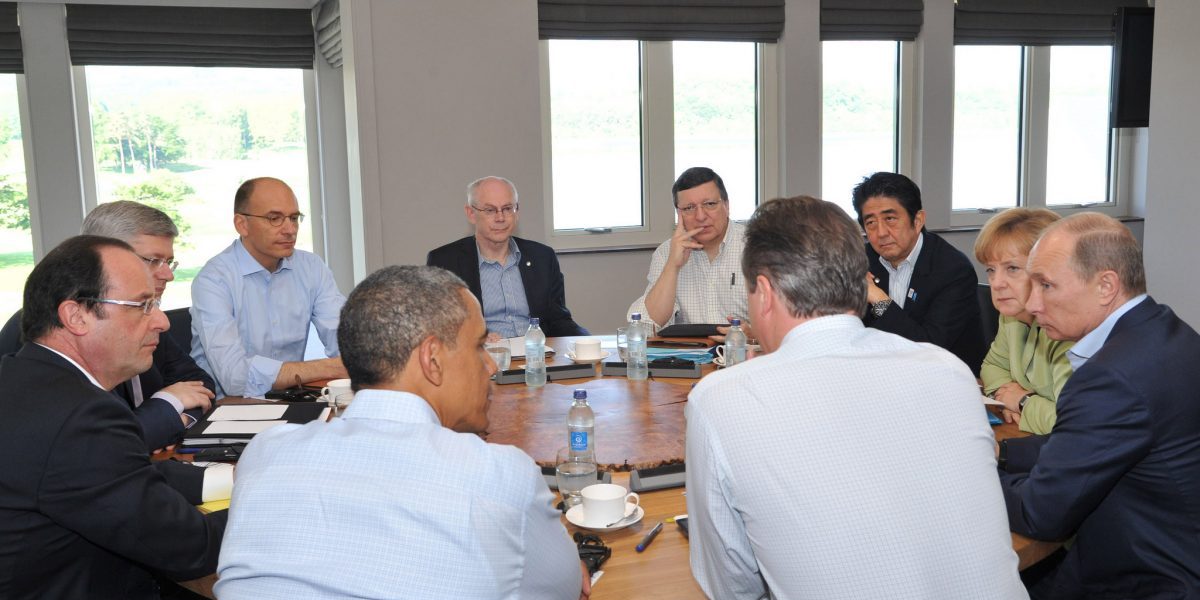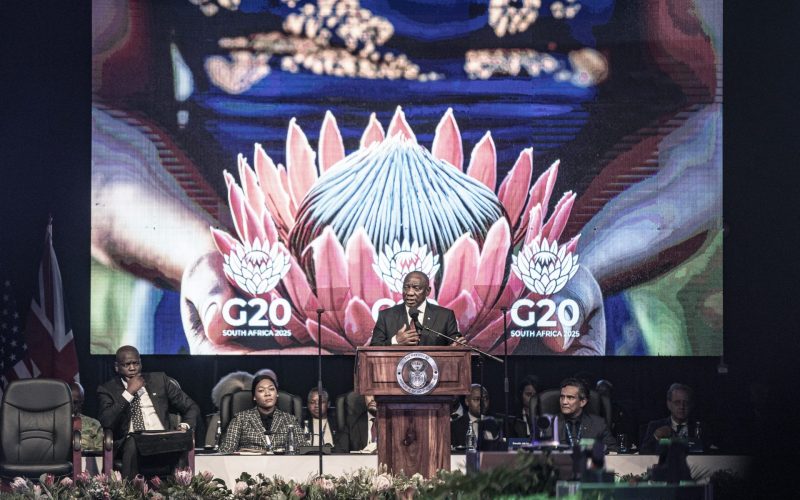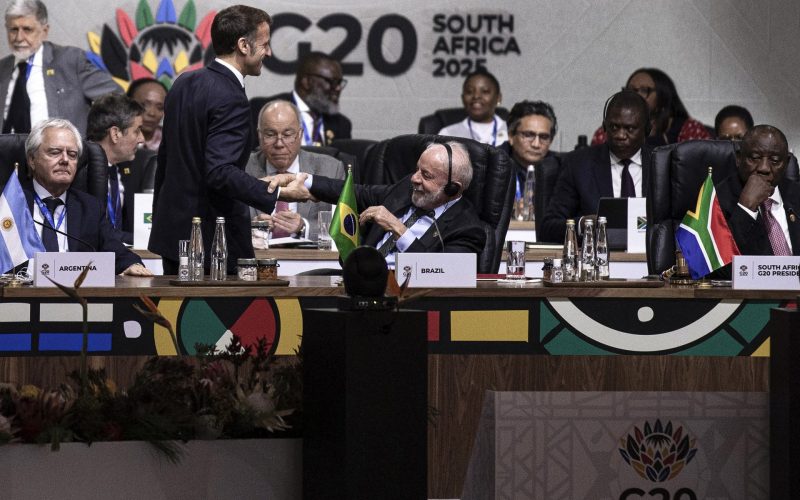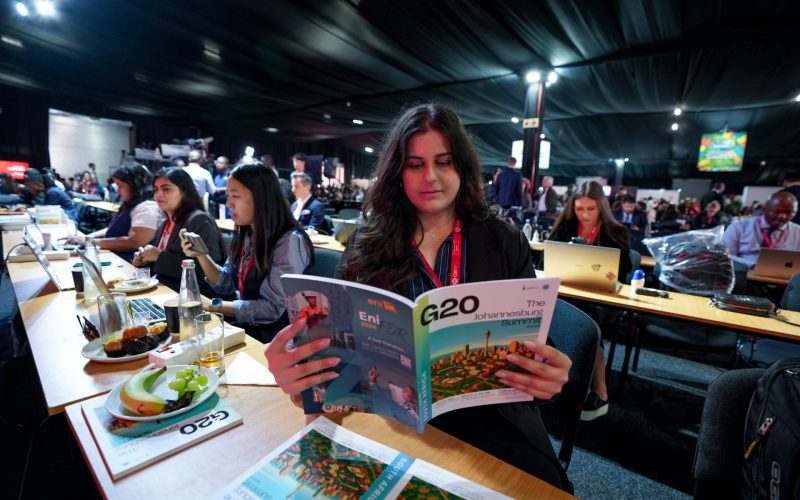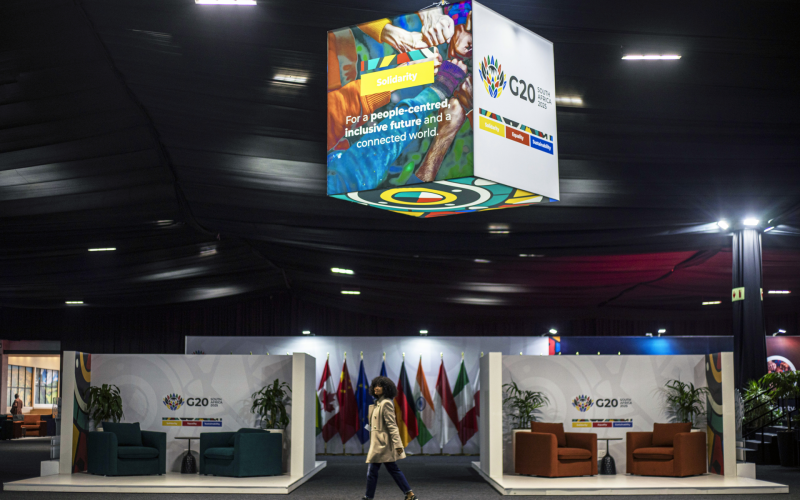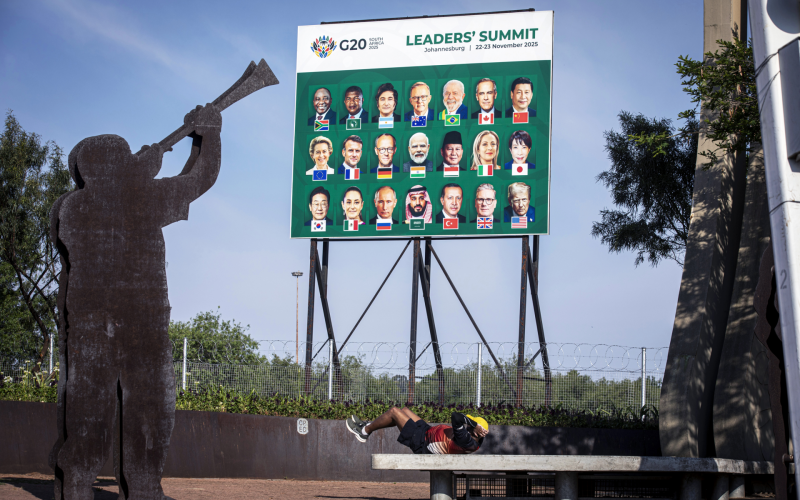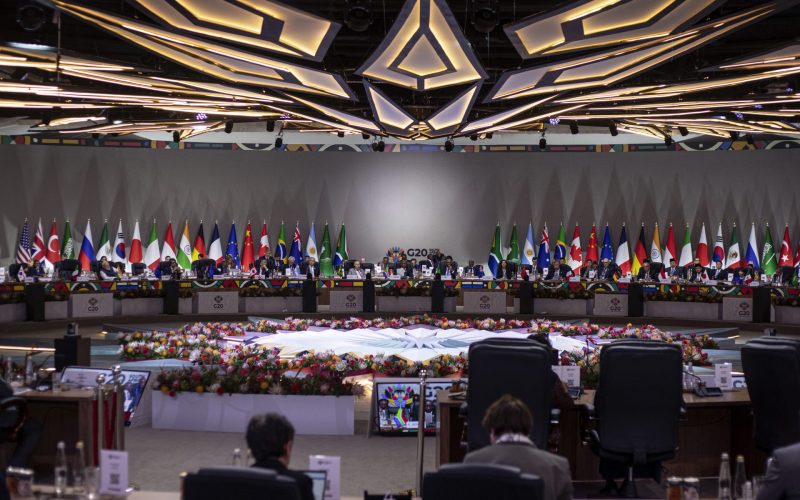Italy’s Presidency Of The G8 And The Summit In L’aquila
History
The G6 was born in Rambouillet in 1975, to discuss upon the consequences of the first oil crisis of 1973, and about how to face them: it was simply meant to be an instrument of co-ordination between the leading industrialised Nations, with a restricted mandate and a limited agenda.
From 1976, it becomes G7 with the inclusion of Canada (to assure a better transatlantic balance).
From 1977, it includes the EU (Commission and Council of Ministers).
From 1997, it officially becomes G8 with the full inclusion of Russia (already participating in some meetings since 1994).
From its original, restricted mandate the G8 has progressively amplified it, to become a leading model of global governance and collective management of the world economy, of the most important political crises and of some major challenges of the global agenda, such as climate change, development (with a particular reference to Africa), food security and trade.
While representing just the 14% of the world population, the G8 represented in 2004 the 65% of the world’s gross product; but this percentage has decreased to 53,3% in 2008, due to the accelerated growth of the major emerging countries.
Since 2000, there has been a stable association to the G8 of the so-called “outreach five”, now more appropriately called the G5: Brazil, China, India, Mexico and South Africa, i.e. the most important emerging economies from three continents which until then had been under-represented or completely absent (as Africa was) from the group: by that, the G8 tried to gain a wider geographical representativity and a consequent greater legitimacy.
Despite its progressive expansion and the considerable, incremental growth of its agenda, the G8 has never changed its basic nature of an intergovernmental and informal Forum; it has always resisted the temptation – so frequent in international relations and so difficult to resist – to create a permanent Secretariat or a bureaucratic structure. All the preparatory work of the annual Summits is still carried out by the national diplomacies of its member countries, each of which is led by a so-called Sherpa. Its Presidency is still rotating with annual frequency; but its yearly Summits have been more and more frequently integrated by preparatory Ministerial meetings on all subjects and topics having some connection with a growing agenda.
2. L’Aquila Summit: context and preparation
The L’Aquila Summit took place in a context of serious international crisis: the worst since 1929. To face this emergency, the G20 – a consultation forum at ministerial level created in response to the Asian financial markets crisis of 1997-98 – had been previously upgraded to Summit level, and as such had been convened twice, in 2008 in Washington and in 2009 in London, where it had adopted a “Global Plan for recovery and reform”. It had demonstrated a good capacity of responding to the crisis co-ordinating the national expansive interventions of the leading economies and of stimulating a reform of the international financial institutions (particularly the IFM). Fatally, the rise of the G20 had induced commentators to question whether the G8 had by now lost its functions, its very “raison d’être”: but this is a problem I’ll discuss later, talking about the future of the G8. In the short term, the rise of the G20 has created for the Italian Presidency the challenge of a proper co-ordination of the decisions to be taken in the economic and financial sector with the results of the London Summit and with the next G20 Summit of Pittsburgh, in September.
Another emergency, this one of a domestic nature, has been the earthquake which struck L’Aquila and the Region of Abruzzo on April 6th. It induced our Prime Minister, Mr Berlusconi, to a bold move: the decision to transfer the venue of the Summit from the small island of La Maddalena, near Sardinia, to L’Aquila. Needless to mention the organisational and logistic problems this decision has caused, a few months before the opening of the big event: but, also thanks to a bit of luck, we are proud to say today that this risky bet has been won. All delegations expressed their satisfaction for the organisation of the Summit under difficult circumstances, and the choice to hold it in L’Aquila has meant a concrete gesture of solidarity with the population which had been hit by the earthquake, and with all those around the world who have been touched by natural disasters.
The Summit was preceded by a particularly long and intense preparatory work, led by the Italian Sherpa, Ambassador Massolo, the Secretary General of our Ministry of Foreign Affairs. Its most outstanding features were the numerous ministerial meetings convened, some of them organised for the first time, in order to put the many themes of the Summit’s agenda into a proper focus. Meetings were organised, in different Italian cities, involving the Ministers of Foreign Affairs, of Finance, of Labour, of Agriculture, of Environment, of Energy, of Justice and Internal Affairs, of Science and Technology and of Development. To almost all of them were also invited, much more often than in the past, the Ministers of the G5 Countries, including South Africa (thus consolidating the collaboration between G8 and G5). Unfortunately, an untimely coincidence with the South African electoral campaign and elections has not always allowed the relevant Ministers of this Country to participate, as we would have liked: when they could not attend, they were represented by high ranking officials of their Ministries.
3. The L’Aquila Summit.
While respecting continuity with the past, the Italian Presidency decided to move forward in the involvement of the major emerging economies, in order to create a stable and structured partnership between G8 and G5, for the first time extended to Egypt as a major representative of the Arab world.
In this spirit, the Summit opened in the G8 format, to later expand, starting from the second day, into progressively enlarged meetings. So, on the first day, July 8, G8 leaders met to discuss upon world economy, development, climate change and international political issues.
On the second day, July 9, they were joined by the G5 Countries plus Egypt, to discuss about a broader range of global issues, and later by the Heads of International Organisations (UN, World bank, IMF, IEA, ILO, OECD and WTO) at a working lunch. In the afternoon, the Major Economies Forum (MEF) leaders met under the co-chairmanship of Prime Minister Berlusconi and President Obama: in addition to the G8 and G5, this meeting included the leaders of Australia, Indonesia, South Korea and the WTO, and the subject under discussion was international trade in these troubled times. Afterwards, the MEF met again, with the addition of the Prime Minister of Denmark (in view of the Copenhagen Climate Summit of next December) and of the UN Secretary General, to discuss upon climate change; and this gathering was followed by a meeting of European Countries participating at the Summit, including the Prime Ministers of Spain, the Netherlands and Turkey.
On the final day, July 10, the G8 met with the African countries (the five founding fathers of NEPAD plus Ethiopia, as current President of NEPAD, Libya, as President of the African Union, Angola upon special invitation of the Presidency and the President of the Commission of the AU, Mr Jean Ping), to discuss upon the impact of the financial crises on Africa; and afterwards these leaders were joined by all the other participants to the Summit, in a meeting of not less that 40 delegations, to examine the problem of food security and to sign the “Aquila Food Security Initiative”, thus underlining – by the mere size of this event – the fact that this theme involves the responsibility of a very broad range of subjects.
By this continuous expansion, as you can see, the G8 exercise reached in L’Aquila the greatest complexity it had ever experienced, following a flexible model of what we Italians call “geometria variabile”, or variable geometry: i.e. a multiplicity of formats which are tailored on the needs of the specific items under discussion. We are convinced that this flexibility is a major asset of this exercise, and will finally justify its continuation and further development in the future.
The L’Aquila Summit has adopted not less than seven official documents, in different formats:
- the G8 Declaration “Responsible leadership for a sustainable future”, which with its 134 paragraphs is the largest and most comprehensive document adopted in L’Aquila;
- the G8 “L’Aquila Statement on Non Proliferation”;
- the G8 “Declaration on Counter Terrorism”;
- the Joint Declaration (G8 and G5 + Egypt) “Promoting the global agenda”;
- the “Declaration of the Major Economies Forum on Energy and Climate”, signed by 17 leaders;
- the Joint G8-Africa Statement “A stronger G8-Africa Partnership on Water and Sanitation”, an historic precedent in its kind, which was also signed by 17 leaders;
- finally, the Joint Statement on “L’Aquila Food Security Initiative” (AFSI), signed by 40 leaders, and as such – if not the longest – the most universal of the official documents produced by the Summit.
Instead of analysing each of these documents, which would imply a rather boring exercise (for me, but especially for you), I prefer to concentrate on the major results of the L’Aquila Summit in relation to the main issues which were discussed, some of them in different formats.
World Economy and international trade: while recognising signs of stabilisation and improved confidence, the main document contains a G8 commitment to implement the decisions of the Washington and London G20 Summits (verifying what has been achieved so far) and to tackle the social dimension of the crisis according to the principle of “people first”. Importance was given to strengthening business ethics (building on the “Lecce Framework” elaborated by OECD), fighting coruption and preparing adequate exit strategies, in view of the Pittsburgh Summit of next September. The G8 Presidency deliberately avoided a duplication of the London Agenda, while stressing its complementarity with the G20.
Together with the G5,the Summit produced a first ever joint statement (“Promoting the global agenda”) engaging all to ensure a “green global recovery based on firm and lasting foundations for sustainable, balanced, innovative and inclusive growth in the medium term” , to avoid competitive devaluations and protectionist measures and “to seek an ambitious and balanced conclusion of the Doha Round in 2010”: an important step forward, considering the arguments between industrialised and emerging powers about the failure to sign the final agreement in 2008. To this end, Trade Ministers of G8 and G5 will meet before the Pittsburgh Summit.
Climate change: in view of the Copenhagen Conference of the end of this year, three were the major objectives of the Italian Presidency:
- an engagement to contain the increase in global average temperature above pre-industrial levels within 2°C, as requested by the scientific community (Intergovernmental Panel on Climate Change) in order to avoid irreversible changes;
- an engagement of developed countries to reduce the emissions of greenhouse gasses by 80% or more by 2050 compared to 1990;
- an engagement of all countries to achieve at least a 50% reduction of global emissions by 2050.
The first two objectives were attained: the MEF Declaration, signed by 17 leaders (including those of the emerging economies) recognises the scientific view that the increase in global temperature should not exceed 2°C (the critics voiced, for instance, by the Indian press on this specific aspect prove that for emerging States this has not been an easy decision); and the G8 main Statement supports a goal of developed countries reducing their aggregated emissions by 80% or more by 2050: a very important agreement, as it helped to bridge the gap which had so long existed between the European and the American positions on this matter, a transatlantic gap. What unfortunately was not possible to achieve (due to resistances by the main emerging economies), is the third objective, i.e. an engagement for a global 50% reduction of emissions by 2050. However, the MEF Statement engages all signatories “to work between now and Copenhagen… to identify a global goal for substantially reducing global emissions by 2050”.
Under the present circumstances, we are reasonably satisfied with the common denominator which was reached after a constructive debate, and we do not share the disappointment which was expressed on this subject by the U.N. Secretary General Ban Ki-Moon. The emerging countries also engaged themselves to reach the peaking of national emissions as soon as possible and “to promptly undertake actions whose projected effects on emissions represent a meaningful deviation from business as usual in the midterm”. We are confident that the conclusions reached in L’Aquila will grant a valuable contribution to the Copenhagen Conference.
Development and Africa. The problem of the impact of the international crisis on developing countries, with a special attention for Africa, has played a major role in discussions within all formats: in particular, it has been the main item for discussion at the working breakfast of G8 and African leaders (plus those of the African Union and the International Organisations) on July 10.
In this regard, the G8 adopted and important package of measures:
- reiteration of the commitments to increase aid made at Gleneagles, including an increase of ODA to Africa of 25 billion a year by 2010, compared to 2004;
- engagement to re-launch the WTO’s Doha Development Agenda, as a motor for a sustainable development;
- an effort to reduce by half the cost of remittances from emigrated labour;
- the reaffirmation of a 60 billion US$ investment to fight infectious diseases and strengthen health systems by 2012;
- a new comprehensive, “whole of the country” approach to development, built on the Monterrey Consensus and aimed at ensuring stronger synergies among all sources of development aid (national governments, local administrations, private sector), with a view to diversifying the mix of available resources and gradually reducing aid-dependency.
Furthermore, for the first time in the G8 history a joint document was signed with African leaders, upon “A stronger G8-Africa partnership on Water and Sanitation”, based on the principles of shared responsibility and mutual accountability.
One of the Summit’s main results was the adoption by 40 leaders (the broadest range of signatories) of the “L’Aquila Food Security Initiative” (AFSI), containing a commitment to mobilise 20 million US$ over three years for sustainable agricultural development, in addition to a strong commitment to ensure adequate food emergency aid. The document recognises that food prices, although decreased since 2008, remain high and volatile, and tries to compensate for a longstanding under-investment in agriculture and food security through an integrated approach, with the aim of advancing by the end of 2009 the implementation of the “Global Partnership for Agriculture and Food Security”.
Finally, I would like to mention a new mechanism that has been introduced at L’Aquila to strengthen the accountability of the G8 with respect to their individual and collective commitments to development: this “broader, comprehensive and consistent methodology for reporting” will be elaborated by a group of high-level experts, and be presented to the G8 Summit of Muskoka in 2010. In our view, this accountability instrument has been one of the most important and innovative achievements of the Summit.
4) Political items.
Political issues were given a particular importance in the Summit’s Agenda, and were discussed in the older, more consolidated and cohesive G-8 format. The results are reflected in the Political Conclusions of the main document adopted, “Responsible Leadership for a sustainable future”, and in two “ad hoc” documents, the L’ Aquila Statements on Non Proliferation and on Counter Terrorism.
The line followed by the Italian Presidency has been to restrict – in comparison with past experiences – the number of the themes under discussion, focussing the debate on the regional crises which most directly affect international security and on the subject of nuclear non proliferation.
Let me concentrate on some of these issues, which I consider of particular interest:
- Iran: overcoming some initial reluctances by Russia, the G8 agreed on a text – the first part of the Political conclusions – that contains three clear messages:
- concern and deploration for the post-electoral violence and repression of the supporters of the opposition;
- commitment to finding a diplomatic solution to the issue of Iran’s nuclear program, with an engagement to take stock of the situation next September, during the G8 meeting on the margin of the UNGA: in other words, the Iranian Government should notice that this window of opportunity will not last forever;
- condemnation of President Ahmadinejad’s declarations denying the Holocaust.
Obtaining Russia’s agreement on this common language is, in our view, one of the main political achievements of the Summit.
DPRK: condemnation “in the strongest terms” of Pyongyang’s nuclear test on 25 May and of its launch of ballistic missiles on 5 April, in violation of UNSC Resolution 1718/2006.
Middle East: full support to the two-State solution, the restoration of Palestinian unity and the freeze in settlement activity, including “natural growth”; readiness to support a future peace agreement through “an ambitious and comprehensive plan for Palestine” (Prime Minister Berlusconi had spoken, in recent times, of a “Marshall Plan for Palestine”: the concept, if not the language, has been included in the Conclusions).
Non proliferation: this subject has obviously benefited from the Russian-American bilateral summit which had taken place on the eve of the L’Aquila Summit. President Obama’s vision of a nuclear-free world and his joint statement with President Medvedev are reflected in the “ad hoc” Statement on this matter, which reiterated the G8’s full commitment to all of the NPT three pillars: non proliferation, peaceful uses of nuclear energy and nuclear disarmament. Such a language would have been unthinkable until a few months ago. In this context, President Obama has announced his project to host, in March 2010, a “Global Nuclear Security Summit” with a view to secure all vulnerable nuclear material around the world, in the wider context of a strategy aiming at preventing the threat of terrorists acquiring weapons of mass destruction. All these are new and very promising developments in view of the 2010 NPT Review Conference.
Counter Terrorism: the “ad hoc” Resolution stresses the key-role of the G8 in this field, and highlights the links of terrorism with organised crime.
5. The Heiligendamm – L’Aquila Process (HAP)
A main ambition of the Italian presidency was to further strengthen the Heiligendamm Process between G8 and G5, which has become the “Heiligendamm – L’Aquila Process” (HAP), a more stable and structured model of association. In a joint document named “The Agenda of the HAP”, the thirteen countries decided to continue this dialogue for a further two years, to review the progress achieved in a report to be presented to the Muskoka Summit of 2010 and to produce a concluding report to the French Summit of 2011.
The main innovation with respect to Heiligendamm is the creation of a HAP Steering Committee co-chaired (upon Italian proposal) by a G8 and a G5 partner country, to be convened alternatively by a G8 and G5 country, in a spirit of equal footing. We think that this new organ will provide the dialogue with a greater continuity and make it more effective and result-oriented. The document includes a non-exhaustive list of possible themes, among other freedom of investments, role of innovation, food security and energy.
6. Main positive results of the L’Aquila Summit
Industrialised – emerging countries relations: The strengthened dialogue between G8 and G5 has allowed some significant progress on some key-issues of the global agenda, such as liberalisation of international trade (thanks to a common engagement for a conclusion of the Doha Round within 2010), climate change (through some important common commitments in view of the Copenhagen Conference) and food security.
Transatlantic relations: L’Aquila has meant a full recovery of the United States to a multilateral dialogue. The new Administration has proved to consider multilateral fora not as a limitation or an obstacle to its power, but as a possible, additional instrument to strengthen it, in harmony and co-ordination with likeminded European partners and with the main emerging countries. This new and welcome attitude of the American Administration has allowed to reach in L’Aquila some significant steps forward on several themes of the Global Agenda, such as non proliferation and climate change.
East West relations: the bilateral summit between Russia and the United States on the eve of L’Aquila’s event paved the way towards a general improvement of the climate of relations between Western partners and Russia, allowing to reach a common language on usually controversial themes of the political agenda, such as Iran, the Middle East, North Korea, Myanmar and non proliferation.
Not all the objectives of the Italian Presidency have been fully achieved, and it would have been irrealistic to hope so; but this does not prevent us from seeing a glass which, in our perception, is more than half full, and from believing that L’Aquila has been a step forward towards a more effective and reliable international governance.
7. The future of the G8
Nowadays, the G8 is often accused of a lack of legitimacy (as it will soon represent less that 50% of the global economic output, besides representing a mere 14% of the world’s population); and of a lack of effectiveness, possibly due to the absence of an autonomous bureaucratic structure empowered to implement its decisions.
The present international crisis has determined the uprise of a possible alternative Forum, the G20. Many have argued that the G20 has a higher degree of legitimacy, as it represents two-thirds of the world’s population, 80% of international trade and 85% of the world’s aggregated product: for these reasons, they claim that the G8 should simply be replaced by the G20.
This is not our view: we believe that the L’Aquila Summit has proved the continuing vitality and usefulness of the G8, thanks to the comparative advantages of a longer tradition and a greater flexibility, and that G8 and G20 are not mutually incompatible Fora.
The G20, in its new Summit format, has been a highly effective instrument for reacting to a very serious international emergency, the financial and economic crisis. We recognise and welcome the success of the Washington and especially the London Summits, and we are confident that this success will be repeated in Pittsburgh next September. Still, we believe that the G20’s function in the future will continue to be substantially limited to financial and economic matters, such as the co-ordination of macroeconomic policies and the reform of the International Financial Organisations. We honestly doubt that such a huge and non homogeneous group will be a useful tool to reach common language and shared decisions on global challenges such as world trade, climate change or development, not to speak of the main political crises on the international agenda. Moreover, the fact that the G20 is the product of an emergency, does not facilitate the task to imagine how it could work in more ordinary times in managing the global issues, including those of economic nature.
The alleged lack of legitimacy of the G8 could be gradually overcome in the future by further strengthening the dialogue and co-operation between the G8 and the G5, with the possible inclusion of Egypt, as we do not think it would be wise to leave the Arab world out of this exercise. The decisions taken in L’Aquila regarding the new Heiligendamm – L’Aquila Process (HAP), a far more stable and structured association in comparison with the original outreach, could become important steps on the road of a gradual transformation of the G8 into a G13 or G14 (if Egypt will be included, as we hope):a perspective which has been anticipated by Prime Minister Berlusconi in his statements after the Summit’s conclusion. The G14 would represent 71% of the world’s aggregated gross output and a large majority of the world population: which would help to vanify the accusations of a lack of legitimacy. Meanwhile, its format would allow more agile and effective decision-making process in comparison with larger and more cumbersome groups. The G14 could really become the main format of a “democratic, responsible and open world governance”, if you allow me to use the words of my Minister of Foreign Affairs, Franco Frattini.
Such a transformation will probably not be immediate: at present, there is no unanimous view among the G8 about the speed this process should take. While Italy, France and the UK favour a rapid transformation – to reflect the many recent changes in the world’s scenario – other members look more cautious; and unanimity is required for any major change in the Forum’s format. Therefore, the G8 will most probably still exist as such at the Canadian Summit of next year and also at some of the following Summits. The political agenda, in particular, will still be likely to be discussed among the countries of the original G8 core group: in L’Aquila, it has not been easy to reach a common language with Russia on Iran; it would have been considerably more difficult, and probably impossible, had the discussion been extended to the G5. Still, in our opinion, this process of expansion from 8 to 13 or 14 is irreversible, and will continue in the future: once it will be concluded, L’Aquila – this unfortunate city, ravaged by a natural catastrophe – will hopefully be remembered as a milestone in this transformation.

